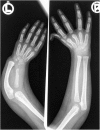Thalidomide and neurotrophism
- PMID: 30341712
- PMCID: PMC6394469
- DOI: 10.1007/s00256-018-3086-2
Thalidomide and neurotrophism
Abstract
Background: Following the thalidomide disaster (1958-62), Henkel and Willert analysed the pattern of dysmelia in the long bones (J Bone Joint Surg Br. 51:399-414, 1969) and the extremities, Willert and Henkel (Z Orthop Ihre Grenzgeb. 107:663-75, 1970). Willert's material from deformed extremities is re-examined here asking "How does thalidomide reduce the skeleton?"
Materials and methods: We reviewed the original data collection of Willert and Henkel (Z Orthop Ihre Grenzgeb. 107:663-75, 1970), comprising musculoskeletal histology slides from 30 children affected by thalidomide with radiographs of hands (19 cases) and feet (4 cases).
Results: All original observations by Willert and Henkel (Z Orthop Ihre Grenzgeb. 107:663-75, 1970), were verified. Radial rays of the hand disappeared early, but the foot was spared until late. Radiology confirms that bone reduction in the hand (aplasia or hypoplasia in the thumb and index finger) coincides with sensory segmental nerve C6. In the foot, reduction of the toes is rare, but mesenchymal excess (polydactyly) occurs in the hallux (L5 sclerotome), usually associated with absent tibia (L4 sclerotome). Histology confirms skeletal mesenchymal components to be unremarkable, contrasting with grossly abnormal bony architecture, a striking discordance between microscopic and macroscopic findings. No necrosis or vascular pathology was seen.
Conclusion: The basic lesion was an abnormal quantity rather than quality of mesenchyme. Cell populations result from cellular proliferation, controlled in early limb bud formation by neurotrophism. Thalidomide is a known sensory neurotoxin in adults. In the embryo, sensorineural injury alters neurotrophism, causing increased or diminished cell proliferation in undifferentiated mesenchyme. Differentiation into normal cartilage occurs later, but within an altered mesenchymal mass. Reduction or excess deformity results, with normal histology, a significant finding. The primary pathological condition is not in the skeleton, but in the nerves.
Keywords: Embryonic sensorineural osteoarthropathy; Embryonic sensory neuropathy; Neurotrophism; Quantitative neuropathology; Thalidomide.
Conflict of interest statement
The authors have no conflicts of interests.
Figures







References
-
- Willert HG, Henkel HL. Pathologisch-anatomische Prinzipien bei Extremitäten Feldbildungen, dargestellt am Beispiel der Finger. Z Orthop Ihre Grenzgeb. 1970;107:663–675. - PubMed
-
- McCredie J. Beyond thalidomide: birth defects explained. London: Royal Society of Medicine Press; 2007.
Publication types
MeSH terms
Substances
LinkOut - more resources
Full Text Sources
Medical

